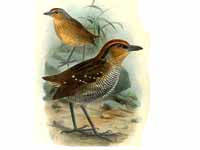Gnateaters eat insects. One way they catch insects is to perch in a tree and plung to the ground when an insect is spotted. They then stay on the ground only briefly. They also take insects directly from the tree. Gnateaters are difficult to spot and thus are poorly studied. They are located in Central and South America. They are round, short-tailed, and long-legged birds, They are quite upright when standing.
The members of this family are very closely related to the antbirds of family Thamnophilidae and less closely to the antpittas (Grallariidae) and tapaculos (Rhinocryptidae).
Genus Conopophaga
Gnateaters are small birds; have short tails; usually have white ear line.
Gnateater,_Ash-throated Conopophaga peruviana Found: Bolivia, Brazil, Ecuador, Peru
The male Ash-throated Gnateater has gray underparts, face; white tuffs behind ears; dark brown wings. Female broadly similar except orange-rufous face, underparts.
Image by: 1) Cornell_Univ's_Neotropical_Birds_Online - Joe_Tobias 2) Nick Athanas - Ecuador1, 2) Male
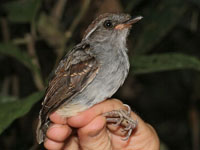
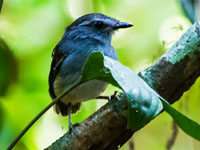
Gnateater,_Black-bellied Conopophaga melanogaster Found: northern Bolivia, Brazil
The male Black-bellied Gnateater has chestnut back, wings, tail; black head with broad white erectile stripe above and behind eye; black underparts. Female has back and wings similar to male; dark gray forecrown; dark brown hindcrown, nape; pale gray supercilium; whitish throat, center of belly; pale gray rest underparts
Image by: 1, 2) Andrew Whittaker Cornell_Univ's_Neotropical_Birds_Online - Andrew_Whittaker1) Female 2) Male

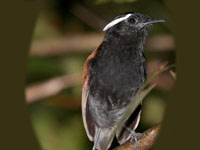
Gnateater, Black-cheeked Conopophaga melanops Found: Brazil
The male Black-cheeked Gnateater mainly brown upperparts; bright rufous crown; black mask; white throat; gray underparts. Female has mainly orange-rufous underparts; darker upperparts; brownish face.
Image by: 1, 2) Dario Sanches 3) Nick Athanas - Brazil 4) Claudio_Timm1) Female 2, 3, 4) Male
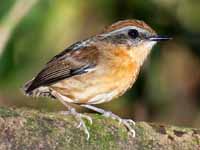

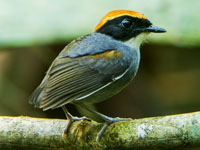
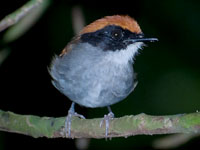
Gnateater,_Ceara Conopophaga cearae Found: northeast Brazil
The Ceara Gnateater was formerly considered a subspecies of the Rufous Gnateater. It has a deeper, more orange-buff color and lacking, or almost lacking, the white crescent found on the lower throat/upper chest of the remaining subspecies of the Rufous Gnateater.
Image by: 1) Cornell_Univ's_Neotropical_Birds_Online - David_Stejskal 2) Hector_Bottai 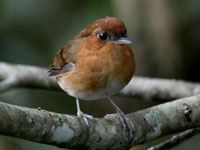
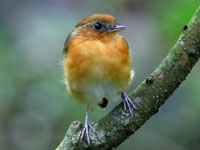
Gnateater,_Chestnut-belted Conopophaga aurita Found: South America
The Chestnut-bellied Gnateater has brown upperparts, crown; white supercilium; buff or white belly; pinkish-gray legs. Male (female) has black (rufous) face, throat; rufous breast.
Image by: 1) Cornell_Univ's_Neotropical_Birds_Online - Marcelo_Barreiros 2) Claudio Timm 3, 4) Nick Athanas - Ecuador, Brazil1) Female 2, 3, 4) Male


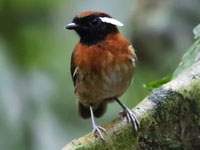
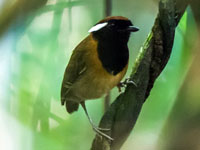
Gnateater,_Chestnut-crowned Conopophaga castaneiceps Found: Columbia, Ecuador, Peru
The male Chestnut-crowned Gnateater has very dark underparts; rufous forehead; long white ear-tufts. Female has brown upperparts; rufous head, throat; shorter white ear-tufts.
Image by: 1, 2) Chrystopher Canaday - Ecuador 3) Jose Loaiza - Ecuador 4) Nick Athanas - Ecuador1, 2) Female 3, 4) Male
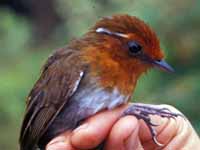
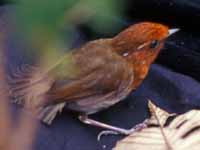

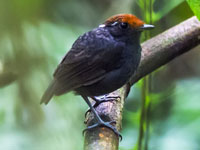
Gnateater,_Hooded Conopophaga roberti Found: northern Brazil
The male Hooded Gnateater has brown upperparts; black head, neck, bib; white ear tuff; gray flanks; white belly. Females have rufous crown; paler rufous ear coverts; gray breast; white throat, belly.
Image by: 1) Antonio Pessoa 2) Claudio Timm 3) Nick Athanas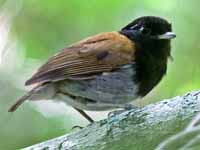
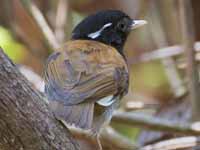

Gnateater,_Rufous Conopophaga lineata Found: South America
The Rufous Gnateater has mainly reddish-brown plumage; white or gray supercilium.
Image by: 1, 5) Nick Athanas - Brazil 2, 3, 4, 6)
Dario Sanches - Brazil1) Female 5) Male
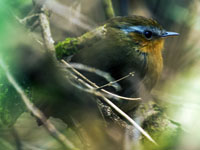
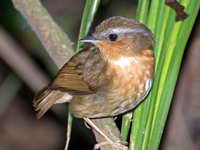

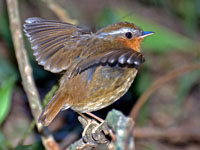
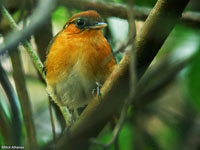
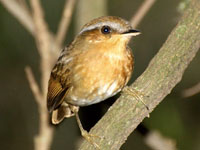
Gnateater,_Slaty Conopophaga ardesiaca Found: Bolivia, Peru
The Slaty Gnateater has brown upperparts; gray throat, breast; white post ear stripe (male); rufous crown.
Image by: 1, 3) Cornell_Univ's_Neotropical_Birds_Online - Joe_Tobias 2) Cornell_Univ's_Neotropical_Birds_Online - Joaquín_Ugarte1) Female 2, 3) Male

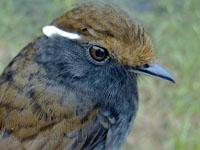

Genus Pittasoma
The two species of Pittasoma are round, short-tailed, and long-legged birds - the largest members of the gnateater family. These terrestrial birds are quite upright when standing. They are insectivorous.
Antpitta,_Black-crowned Pittasoma michleri Found: Colombia, Costa Rica, and Panama.
The Black-crowned Antpitta has olive-brown upperparts; black crown, throat; black and white scalloped underparts,
Image by: 1) Cornell_Univ's_Neotropical_Birds_Online - Andrew_Spencer HarmonyOnPlanetEarth 1) Female 2) Male
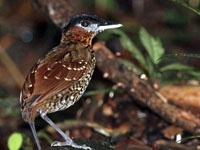

Antpitta,_Rufous-crowned Pittasoma rufopileatum Found: Colombia, Ecuador.
The male Rufous-crowned Antpitta has olive-brown upperparts with broad black streaking; rufuous crown; broad black eye-line; whitish underparts with wavy black barring. Female has less bright crown.
Image by: 1) John Gerrard Keulemans 2) Nick Athanas- Ecuador 2) Male
